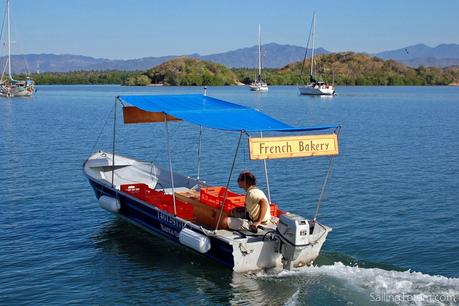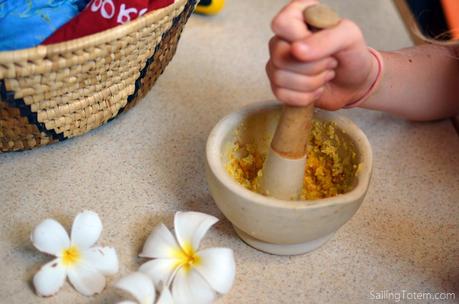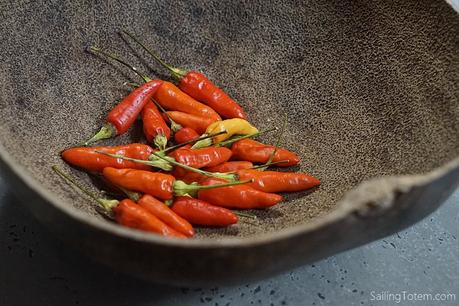
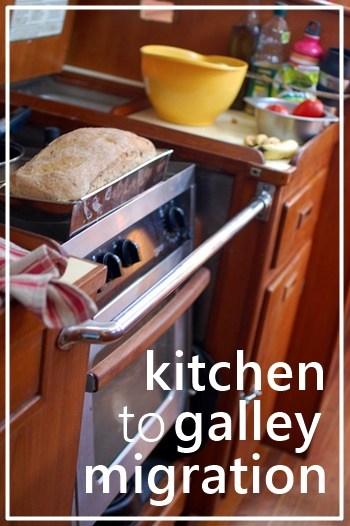
We love to cook. Moving from a spacious, well-equipped kitchen on land to a compact galley on a sailboat did nothing to impact our enthusiasm for creating and enjoying delicious meals. Until you live this truth, it may feel elusive; it’s easy to presume that cooking aboard approximates camping cuisine. I want to kick that misconception to the curb. Or reef. Or whatever!
This post is part one in a series of galleywise topics, starting with a look at kitchen appliances. What makes the transition to the boat, what doesn’t, and how we compensate for equipment that doesn’t cross over. Are there some compromises? Probably, but do I feel for a moment deprived? Absolutely not!
[Yesterday’s article and video in CNN brought a raft of visitors. If you’re new to our blog, you might want to Start Here or read Who and Why. Welcome!]
Our kitchen on land included a professional range and more electrics than I can count on my hands. Some were everyday appliances, like our espresso machine; others had specialty use, like the Kitchen Aid standup mixer. We liked to entertain and these tools made it easier to cook for a crowd.
Aboard Totem, our galley may be a micro-sized and lightly equipped by comparison, but hasn’t compromised what we’re able to do. We still love to cook, to share meals aboard with friends, to explore the world through tastes and dishes. It cracked me up to see that CNN’s choice of a thumbnail for the video about our family happened to reference our love of food. THAT’S US!

In truth: most of our kitchen appliances did not get to the boat. It’s also true that I don’t miss them. OK, that’s a lie. Whipping cream by hand is a pain in the arm, but that’s why I have helpers! But only rarely do the gadgets offer function that can’t be replicated with a simpler tool, or time, or both. Here’s a comparison of commonly used appliances and how they fit in our land-to-boat transition.
On shore:On Totem:
BlenderImmersion blender. This gadget (aka stick blender, hand blender) makes everything from smoothies to pureed soups to hummus. AC powered and a big amperage draw, but that’s OK since it’s only on for about 30 seconds! Ours is a much older version of this 400 watt model. Don’t undersize the wattage! At a more extreme end, I have a friend on a relatively low-tech boat that sized their inverter JUST so she could have her VitaMix on board.
Food processorMandoline. What can I say, I like making perfectly thin and uniform slices of vegetables sometimes! This makes easy, pretty work of things like potatoes and tomatoes. Get 3-4 years from the blades, we currently have an Oxo mandoline.
More chopper than processor, but there are manual devices that stand in for smaller jobs. Many immersion blender models come with an attachment bowl with a blad powered by the wand.
MixerFor more general mixing, a bowl and spoon are enough. For whipping cream, beating egg whites, or emulsifying aioli (OK so that’s about once a year), a flat whisk stores compactly and gets the job done with a little elbow grease. Helpers are nice.
Coffee/espresso machineNothing! There are many ways to make coffee aboard, but our shmancy machine isn’t necessary. OK, so I do miss the frother/steamer for milk…
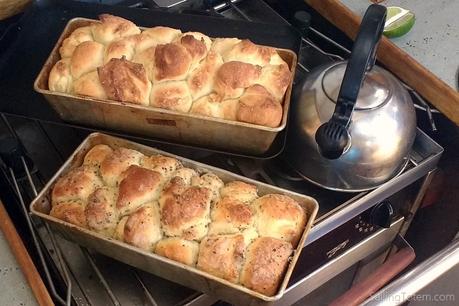
Bread machineMaking bread by hand is actually pretty easy; it just takes time, which we have. Sometimes the bread onshore is good enough that I don’t feel compelled (why compete with baguettes on a French island?). Bread machines need space and power, so aren’t a great fit for most boats, but cruisers with power to run one benefit from a cooler galley when baking bread. (Land- and sea-version recipe for our favorite bread, pictured above, in this post.)
MicrowaveThere’s a stove? Microwaves offer convenience we don’t need. The best use other than reheating might be making a hot drink for night watch – but if you’re moving around much on a passage, kettles are safer than the microwave as vessel for boiling hot water.
ToasterStovetop. Some boats have a toaster; we just make toast in a griddle pan on the stovetop; monitoring necessary, but an electric appliance is not required.
Crock potPower-hungry crock pots aren’t a good fit for most boats. Our Solavore solar oven acts a lot like a crock pot, cooking at low temperatures for hours; we don’t have one, but friends who do swear by a Thermal Cooker or Wonderbag for the same purpose: slow, unattended cooking.
Instant potPressure cooker. A pressure cooker on steroids is all that Instant Pot is! Modern pressure cookers are kind of awesome; programmable functions aren’t necessary.
Some boats do have items we chose to forego; it’s a function of having space and power to make them work. But my point here: so much of what we’re convinced are “needs” … aren’t, really. Like a lot of life afloat, things are simpler. Pared back, what served as a helpful convenience before becomes unnecessary clutter.
